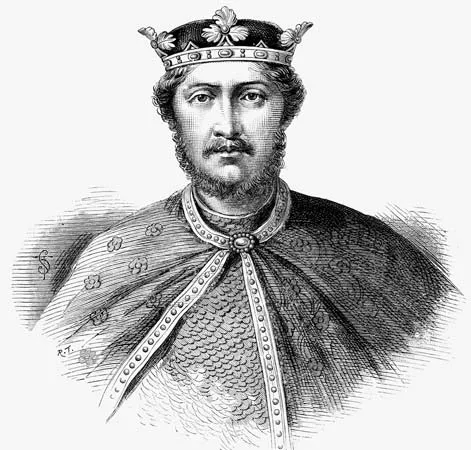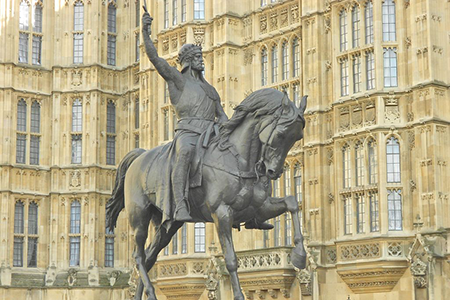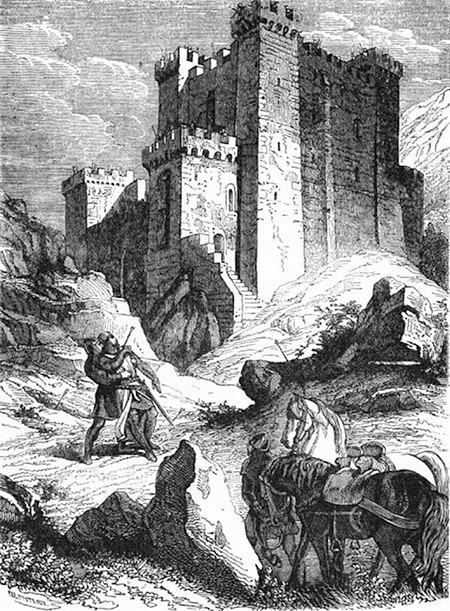



King Richard I Lionheart Ė Quick Stats




Born: September 8, 1157, at Beaumont Palace, Oxford, England
King Richard I the Lionheart: Warrior King and Crusader Legend
Richard I of England, known as Richard the Lionheart, was one of the most legendary kings in English history. Renowned for his military prowess and leadership during the Third Crusade, he became an enduring symbol of chivalry and medieval kingship.
His reign, though short, left a lasting impact on England and the European world. His legacy as a warrior-king continues to be celebrated in historical narratives, literature, and folklore, shaping the perception of medieval chivalry and leadership. Richardís life was filled with adventure, political intrigue, and conflict, making him a compelling figure of the Middle Ages.
Early Life and Ascension to the Throne
Richard was born on September 8, 1157, at Beaumont Palace in Oxford, England. He was the third son of King Henry II and Eleanor of Aquitaine. Despite being a younger son, he emerged as a powerful and ambitious noble, showing great skill as a military leader from an early age.
Richard was born on September 8, 1157, at Beaumont Palace in Oxford, England. He was the third son of King Henry II and Eleanor of Aquitaine. Despite being a younger son, he emerged as a powerful and ambitious noble, showing great skill as a military leader from an early age.
He was particularly close to his mother, Eleanor, and inherited much of her political acumen and strong will. His upbringing was marked by rigorous training in military strategy, governance, and chivalric values, preparing him for the life of a warrior and ruler.
As Duke of Aquitaine and Poitiers, Richard led several military campaigns in France, often rebelling against his father alongside his brothers. His struggle for power culminated in 1189 when Henry II died, and Richard ascended to the throne of England.
Unlike his predecessors, Richard spent much of his reign abroad, focusing on military campaigns rather than domestic affairs. His coronation in Westminster Abbey was marked by grandeur, reflecting his ambition to cement his status as a powerful European ruler. His early reign was characterized by consolidation of power and securing his position among European monarchs.
The Third Crusade
One of Richardís most famous endeavors was his participation in the Third Crusade (1189Ė1192), aimed at recapturing Jerusalem from Saladin, the formidable Muslim leader. Richard proved to be an exceptional warrior, winning key victories, including the capture of Acre and the Battle of Arsuf.
One of Richardís most famous endeavors was his participation in the Third Crusade (1189Ė1192), aimed at recapturing Jerusalem from Saladin, the formidable Muslim leader. Richard proved to be an exceptional warrior, winning key victories, including the capture of Acre and the Battle of Arsuf.
Later Reign and Death
Upon his return to England in 1194, Richard spent little time in his kingdom, preferring to focus on his territories in France. His conflicts with King Philip II of France intensified as both sought dominance over key territories. Richard engaged in continuous battles against Philip to maintain and expand his holdings.
Upon his return to England in 1194, Richard spent little time in his kingdom, preferring to focus on his territories in France. His conflicts with King Philip II of France intensified as both sought dominance over key territories. Richard engaged in continuous battles against Philip to maintain and expand his holdings.
During a siege at Ch‚lus-Chabrol in 1199, Richard was struck by a crossbow bolt while inspecting the castleís defenses. The wound became infected, leading to his death on April 6, 1199. His death marked the end of an era, as England transitioned to the rule of his brother, King John, whose reign would be fraught with internal strife and conflicts with the nobility. Richardís death was deeply mourned by his loyal supporters, and his burial at Fontevraud Abbey in France symbolized his dual identity as both an English and Angevin ruler.
Legacy
Richard the Lionheart remains one of Englandís most iconic monarchs. He was celebrated for his bravery and military achievements, though his reign saw little domestic governance. His focus on warfare drained Englandís resources, but his reputation as a valiant warrior-king persisted for centuries. He is buried at Fontevraud Abbey in France alongside his parents, signifying his deep ties to both England and the Angevin territories in France. His life and exploits have inspired numerous historical accounts, artistic representations, and literary depictions.
Richard the Lionheart remains one of Englandís most iconic monarchs. He was celebrated for his bravery and military achievements, though his reign saw little domestic governance. His focus on warfare drained Englandís resources, but his reputation as a valiant warrior-king persisted for centuries. He is buried at Fontevraud Abbey in France alongside his parents, signifying his deep ties to both England and the Angevin territories in France. His life and exploits have inspired numerous historical accounts, artistic representations, and literary depictions.
His legend lives on in literature, folklore, and historical narratives, immortalizing him as one of the greatest crusader kings of the Middle Ages. He has been depicted in countless stories, including the tales of Robin Hood, where he is often portrayed as the noble king whose absence leaves England vulnerable to tyranny. His military strategies, diplomatic maneuvers, and enduring legacy continue to be studied by historians, reinforcing his place as one of the most remarkable figures of medieval history.
His ability to lead troops in battle and his strategic acumen earned him the respect of both allies and enemies. Although he did not reclaim Jerusalem, his strategic negotiations secured Christian access to the Holy City.
His rivalry with King Philip II of France and disputes with other European leaders, including Leopold V of Austria, complicated the crusade. Despite these challenges, Richardís military successes solidified his reputation as a formidable warrior. After failing to capture Jerusalem, Richard agreed to a truce with Saladin, allowing Christian pilgrims access to the holy sites. This agreement, though falling short of total victory, was seen as a significant diplomatic achievement. His leadership during the crusade showcased his tactical brilliance, courage, and ability to inspire his troops, reinforcing his status as one of the great warrior-kings of medieval Europe.
Captivity and Ransom
On his return journey to England, Richard was captured by Leopold V of Austria and later handed over to Emperor Henry VI of the Holy Roman Empire. His capture was a significant political crisis, as his enemies sought to exploit his absence. He was imprisoned for over a year, and his release required an enormous ransom of 150,000 marks, a sum that significantly strained Englandís finances. The ransom was raised through heavy taxation and contributions from his subjects, demonstrating the loyalty and financial burden placed upon the kingdom in securing his freedom.
On his return journey to England, Richard was captured by Leopold V of Austria and later handed over to Emperor Henry VI of the Holy Roman Empire. His capture was a significant political crisis, as his enemies sought to exploit his absence. He was imprisoned for over a year, and his release required an enormous ransom of 150,000 marks, a sum that significantly strained Englandís finances. The ransom was raised through heavy taxation and contributions from his subjects, demonstrating the loyalty and financial burden placed upon the kingdom in securing his freedom.
During his captivity, his mother, Eleanor of Aquitaine, played a crucial role in securing his release. She rallied support across England and Europe, ensuring that the necessary funds were collected. Richardís prolonged absence also allowed his younger brother, John, to scheme for the throne, further complicating the political landscape. His eventual release in 1194 was celebrated across England, though his return was brief. The ordeal of his imprisonment highlighted the volatility of medieval politics and the high-stakes power struggles among European rulers.
Died: April 6, 1199, at Ch‚lus, Aquitaine, France (aged 41)
Mother: Eleanor of Aquitaine
Father: King Henry II of England
Wife: Berengaria of Navarre (married in 1191)
Children: None (no legitimate heirs)
Successor: King John (his younger brother)
Predecessor: King Henry II (his father)


His military campaigns were relentless, characterized by strategic sieges, decisive battles, and shifting alliances. His ability to conduct siege warfare was particularly notable, as he effectively utilized engineering and military innovations to overpower enemy strongholds.
Statue of King Richard I outside Houses or Parliament

While his reign was marked by continuous warfare and personal ambition, Richardís impact on the medieval world is undeniable. His ability to inspire loyalty among his troops, his unwavering commitment to the crusades, and his strategic prowess ensured that his name would be remembered throughout history.
Despite his limited time in England, his influence shaped the course of the kingdomís development and its role on the European stage. His life exemplifies the ideals of medieval kingship, where martial skill, diplomacy, and personal ambition defined a rulerís legacy. The Lionheart remains an enduring symbol of courage, determination, and the warrior spirit that characterized the medieval age.
Depiction of King Richard Death Wound by Crossbow Bolt


